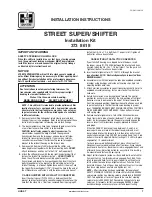
3) Cylinder Head and Valve Train
The cylinder head is made of cast aluminum alloy and has four combustion chambers arranged in-line.
Each combustion chamber has an intake and an exhaust ports.
Moreover, as shown in Figure 3-l-3, the air induction nozzle is provided near each intake valve. During
intake stroke of the engine, air/fuel mixture enters into the combustion chamber from carburetor through
intake manifold and intake valve. At the same time, air flows to the air induction nozzle through carbure-
tor and air induction passage in the intake manifold, and jets into the combustion chamber.
The air jetted into the combustion chamber accelerates the mixture swirl to improve the combustion
efficiency.
A single overhead camshaft driven by the crankshaft through the timing belt is mounted on the cylinder
head. The camshaft has eight cams, and each cam operates the intake or exhaust valve through rocker arm.
The valve lash can be adjusted by turning the adjusting screw on the rocker arm after loosening the lock
nut.
1. Intake valve
2. Exhaust valve
3. Rocker arms
4. Camshaft
6. Air induction nozzle
6. Air induction passage
7. Intake manifold
a.
Carburetor
Fig. Cylinder head and valve train
4) Cylinder Block
The cylinder block is made of cast aluminum alloy and has 4 cylinders arranged “In-Line”. A cylindrical
cast iron sleeve is installed in each cylinder.
5) Crankshaft and Main Bearings
A monoblock casting crankshaft is supported by 5 main bearings which are of precision insert type. Four
crank pins on the crankshaft are positioned
apart.
6) Pistons, Rings, Piston Pins and Connecting Rods
The piston is cast aluminum alloy, and has two compression rings and one oil ring.
Among two compression rings (top and 2nd rings), the top ring is plated with hard chromium for improve-
ment in abrasion resistance.
The oil ring consists of two rails and one spacer.
The piston pin is offset. 0.5 mm towards the major thrust side. This allows a gradual change in thrust
pressure against the cylinder wall as the piston travels its path. Pins are chromium steel and have a floating
fit in the pistons. They are retained in the connecting rods by a press fit. The connecting rods are made of
forged steel, and the rod bearings are of precision insert type.
3-4
Содержание Samurai 1986
Страница 1: ......
Страница 9: ...0 9...
Страница 10: ...0 6...
Страница 11: ...0 7...
Страница 12: ...0 8...
Страница 13: ...0 9...
Страница 14: ...0 10...
Страница 15: ...0 11...
Страница 19: ...1 2...
Страница 20: ...1 3...
Страница 119: ...r a l I 29 Fig 4 1 1 Carburetor exploded view 4 3...
Страница 120: ...N Fig 4 l 2 Carburetor cross section 4 4...
Страница 154: ......
Страница 155: ...T c c x 5 5 3...
Страница 347: ...Fig 17 1 34 17 12...
Страница 348: ...17 13...
Страница 353: ...Fig 17 2 12 17 18...
Страница 354: ...17 19...
Страница 360: ...Fig 17 3 19 Fig 17 3 20 Fig 17 3 21 5 Fig 17 3 23 Ci Fig 17 3 24 Fig 17 3 22 17 25...
Страница 379: ...Steering Lower Shaft and Joint Universal joint rubber joint bolt Steering rubber ir Fig 18 31 11 0 18 0lb ft 18 15...
Страница 424: ...Fig 19 6 1 19 38 19 6 PARKING BRAKE...
Страница 448: ...20 13...
Страница 450: ...21 2...
Страница 475: ...22 5...
Страница 476: ...22 6...
Страница 477: ...22 7...
Страница 478: ...22 8...
Страница 479: ...22 9...
Страница 480: ......
Страница 481: ......
Страница 482: ...Prepared by SUZUKI MOTOR CO LTD Technical Department Automobile Service Division 1st Ed November 1987 Printed in Japan...
















































